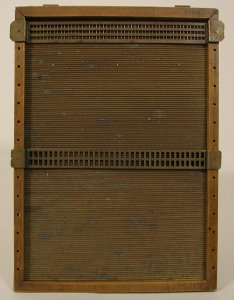

- Writing: Braille Slates, Braillewriters, and Writing Guides
- The early tactile alphabets developed for people who were blind or visually impaired were difficult to produce without a printing press. Dot codes, however, could be easily written with simple hand tools. Charles Barbier, who introduced the dot syste... View Exhibit Page

- Talking Books: Recorded Books and Playback Equipment
- In 1932, the American Foundation for the Blind began experiments to make the recording of books for the blind practical. APH installed its own model sound recording studio in 1936 and was soon equipped to manufacture talking book records from wax rec... View Exhibit Page

- Tactile Printing: First Books and Early Presses
- The earliest efforts to make reading possible for blind people employed a tactile version of the Roman alphabet. The first such book was printed in Paris, France in 1786 by Valentin' Hauy. Later inventors experimented with tactile codes. Louis Braill... View Exhibit Page

- Educational Aids: Spelling, Math, Geography, Science, and Music
- The challenge of learning subjects beyond reading and writing lies in the differences between receiving information with the eyes and with the fingertips. The eye moves immediately across the whole image; the finger perceives objects from the part to... View Exhibit Page

- Large Type: Books for Students with Low Vision
- Robert Irwin organized classes for low vision students in 1913 in Cleveland, Ohio. Two years later, he started a company to publish textbooks in large type. In 1936, in response to requests for large type books, APH printed a test edition of "Everyda... View Exhibit Page

- First Schools: Residential Programs for Children Who Are Blind or Visually Impaired
- The first school for the blind was founded in France in 1784 by Valentin' Hauy. Civic leaders founded the first three schools for the blind in America in Boston (1829), New York (1831), and Philadelphia (1832). The first state supported school was fo... View Exhibit Page

- APH Corporate Memory Project: Our Oral History
- In 2004, the Printing House began a project to record the stories of its retired staff. To date, the project has captured interviews from over eighty current and former APH employees, board members, and ex officio trustees, covering the last half ce... View Exhibit Page

- Eye of the Beholder: Images of People with Vision Loss in the Nineteenth Century
- Although sometimes unable to appreciate the art of the studio photographer, people with vision loss were just as likely to sit for a family photo as other Americans. This exhibit explores the museum's collection of late nineteenth and early twentiet... View Exhibit Page

- The AER O&M Division Bledsoe Archives: The Professionalization of Orientation & Mobility
- The Bledsoe Archives documents the history and development of the Orientation & Mobility (O&M) profession and the history and activities of the AER Orientation & Mobility Division. It consists of two major record groups: the C. Warren Bledsoe Manusc... View Exhibit Page









